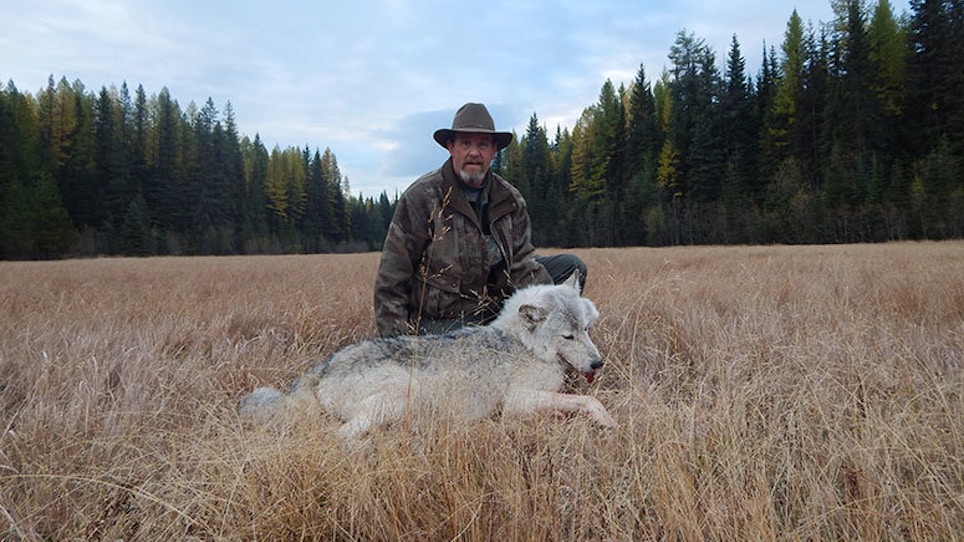Jay Sheffield | Montana
 I hiked and hunted coyotes all summer and never saw a single pile of fresh wolf scat. Five years ago you had to watch where you stepped, but that has definitely changed. Contrary to the claims made by many about being overrun by wolves here in northwestern Montana, we are not. Whether the reduction is due to managed hunting and trapping and its subsequent disruptions to pack structures and breeding cycles, or more likely a lot of folks freely engaging in the management practice of shoot, shovel and shut up, it is a reality. The remaining wolves have quickly adapted to being hunted and are much warier than those of even a few years ago. I am not commenting on whether these changes are good or bad, it’s just how it is.
I hiked and hunted coyotes all summer and never saw a single pile of fresh wolf scat. Five years ago you had to watch where you stepped, but that has definitely changed. Contrary to the claims made by many about being overrun by wolves here in northwestern Montana, we are not. Whether the reduction is due to managed hunting and trapping and its subsequent disruptions to pack structures and breeding cycles, or more likely a lot of folks freely engaging in the management practice of shoot, shovel and shut up, it is a reality. The remaining wolves have quickly adapted to being hunted and are much warier than those of even a few years ago. I am not commenting on whether these changes are good or bad, it’s just how it is.
The Montana general wolf season had been open for about three weeks and after numerous stands I had not heard so much as a howl. I decided to mount a bit of an expedition and headed out before daylight to a fairly remote basin. It was still dark when I parked the truck and headed down the trail. When I got to a good spot I let out a short howl, and to my astonishment it was instantly answered by an entire pack of wolves. I was fairly sure I knew where they were so I hustled down a steep trail that would take me to a seasonal (now dry) lake bed. I howled again and was quickly answered by another chorus of howls. The closer I got, the slower I went. As the trail reaches the lake bed it flattens out and there are some thick bushes along the edge. With winter rapidly approaching many of their leaves had already fallen. I snuck into those bushes and with a clear field of view, sat down and let out a very short howl. To my amazement, seven wolves soon walked out into the short grass. It was still a little dark, but I could clearly see there was one very pale wolf in the lead and it was bigger than the others. They were about 150 yards out but slowly working their way across the dry bed towards me. They would frequently stop and sniff things; a pair was basically playing around and would nip at the others. They were completely relaxed. I sat for several minutes watching them continue to come my way. Around 75 yards they basically stalled out. I wanted to see if I could get them in really close for a double, so I gave a very quick soft whine. Even though it was soft, they all heard it and instantly looked my way.
I was hidden, sitting with my elbows on my knees, rifle at the ready, safety off. I had been tracking the big pale wolf in my scope the whole time because I knew that even in the dead calm of morning one whiff of me on an unseen breeze and they would be gone in an instant. I needed to be ready. They started to move my way again although I could tell they were now more alert and cautious. Around 35 yards I saw the male and another wolf both lift their noses nearly simultaneously then they all stood still. Fearing I was busted, I settled the green triangle of my Trijicon scope on the pale wolf’s shoulder and pulled the trigger. At the shot I saw the wolf drop, but as I cycled the bolt I saw him struggling to stand back up. His front end was down, but by using his hind legs he would spin in a circle then fall back down. He did this at least twice more. I saw the other wolves scatter when I fired, but I can clearly remember seeing a few hang up 50 to 75 yards out. Unfortunately, my shot was lower than it should have been and instead of killing him instantly, it struck his left leg below the shoulder and went low across his abdomen. It was a devastating injury that would prove fatal in about 15 seconds, but I did not know that at the time and I was determined to shoot him again if he regained his feet. Tracking a wounded wolf in these mountains is not something I ever want to do so I covered him until it was over. Sadly, the time that I spent covering the male until he went down gave the others the time they needed to regain their bearings and bolt for the timber. For about a half second I lamented my lost opportunity for a double, but that was replaced almost immediately with the incredible excitement of taking a giant male that was obviously the pack leader.
I continued to sit for a minute watching for movement in the woods, but they were all gone. It sounds crazy now, but after walking over to the wolf I howled as long and as loud as I possibly could. Several wolves that were now up on the hillside hidden in the trees howled back. We all howled a few more times then there was silence. I knelt down and examined the pale wolf; his coat was thick in preparation for the coming winter, the body rock solid with little fat. His head was huge and contained a set of very large well-worn teeth. This animal was perfectly adapted to not only survive but to actually thrive in some of the harshest conditions imaginable.
After validating my tag, I set up a camera to take some photos. One of the downsides to hunting alone is at picture time. Balancing a camera on my backpack and taking photos by repeatedly resetting the 10-second timer then running around to get in the frame a couple dozen times gets old quickly! But, as you all know, a good photo is something that will be shared and treasured for a lifetime. I dug out my reading glasses to confirm there were at least a few good pictures then gathered up all of my gear.
I was determined to get this regal animal out in one piece for delivery to my taxidermist. My plan was to use my deer drag to get him across the smooth, dried grass to the trailhead then load him on a pack frame currently located a half mile away in my truck for the trip back up the mountain. Just pulling him was harder than I would have thought and that was weighing heavy on my mind as I hiked back up for the freighter pack. Once at the truck, I shed my hunting pack, coat, hat and anything else that would weigh me down or cause me to overheat. I hustled back down the trail but eased in the last few hundred yards on the off chance a wolf might come back to check on the leader. I sat and watched for a few minutes but nothing had returned.
As I struggled to lash the wolf onto my pack I was already starting to realize that my plan might not work. I soon discovered that I could not lift the pack high enough to put it on; in fact, I could barely get it high enough to balance on my slightly bent knee. I tried lying down and wiggling into the pack like an upside down turtle but that did not work either. After 10 minutes of struggling I was at a loss about what to do. I finally had the bright idea to work the pack up to my knee then shove it wolf first into the branches of a small tree. This gave me just enough leverage to support the pack and squirm into the shoulder straps. I could then lean forward and buckle the waist belt. With the pack now on, I realized the adrenaline rush from earlier was long gone and it was literally all I could do to walk with more than 100 pounds on my back. Going very slowly and stopping every few steps I slowly made my way up the trail. I was absolutely determined to make it to the truck, and with no other options I pressed on until I reached the top. I decided right then I will never again attempt a load like that. Not only was the risk of falling great, but at my age so was the risk of major physical injury. I know now I was not honest with myself regarding my physical abilities to carry such a load, something that we should all think hard about before getting into something we can’t get ourselves out of. I accept this type of solo adventure may someday be the end of me, but until then I will strive to be smarter when “pushing the edge of the envelope.”
Being totally alone in a remote mountain basin 30 miles from civilization and experiencing an event this primal is something few people will ever do or understand. It is also the reason that I am positively obsessed with wilderness predator hunting!
Want to see your article in Predator Xtreme? Send us your predator hunting story or hunting tip (350 words) and one to two high-resolution digital images to molis@grandviewmedia.com.






